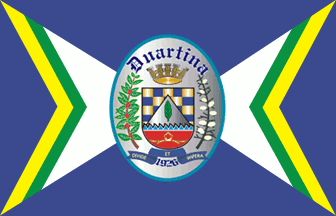 image by Dirk Schönberger,
23 October 2012
image by Dirk Schönberger,
23 October 2012Source: http://www.duartina.sp.gov.br/bandeira.html

Last modified: 2012-11-04 by ian macdonald
Keywords: sao paulo | duartina |
Links: FOTW homepage |
search |
disclaimer and copyright |
write us |
mirrors
 image by Dirk Schönberger,
23 October 2012
image by Dirk Schönberger,
23 October 2012
Source:
http://www.duartina.sp.gov.br/bandeira.html
A saltire-like design, the upper and lower sectors dark blue, and the hoist and fly sectors with nested triangles blue, yellow, green white from the edges in, with a central light blue-edged oval bearing the municipal arms.
Official website at
http://www.duartina.sp.gov.br
Dirk Schönberger,
22 October 2012
Duartina originates in Patrimônio de Santa Luzia, established on 13 December 1920 by Theodósio Lopes Pedroso. The district of Santa Luzia de Serrote was established on 16 December 1922 by Law No. 1,893. The railway station inaugurated in 1925 was named, according to the alphabetic order, Duartina, for Carlos Duarte da Costa (1888-1961), second Bishop of Botucatu (1924-1937), excommunicated in 1945 by Pius XII and founder, a few days later, of the Brazilian Catholic Apostolic Church. Duarte is remembered in São Paulo as a main supporter and fundraiser of the Constitutionalist Revolution (1932). The municipality of Duartina was established on 1 December 1936 by Law No. 2,151.
The coat of arms, the flag and the anthem are listed, without further description, as the municipal symbols in Article 4 of the Municipal Constitution.
The flag of Duartina is prescribed by Municipal Law No. 1,839 of 10 November 2006. "The flag is made of the blue, white, yellow and green colours. It is composed of four arrows, two on the right and two on the left, green, yellow and white, placed on a blue field. In the middle of the flag is placed the municipal coat of arms already prescribed by a Municipal Law, increased with the writing 'DUARTINA' and the year '1926' recalling the political and administrative emancipation of the municipality, below a scroll inscribed with the motto 'DIVIDE ET IMPERA'. The coat of arms is inscribed in an ellipse argent limited by a light blue outline.
The meaning of the flag are: All those who see the Duartina flag shall
have their face trembling; confidence shall be everyone's achievement;
work shall be everyone' right; hope shall be shared by all; peace and
union shall be in everyone's heart in Duartina.
The four arrows symbolizes the ways to progress in Duartina designed
by everyone's hands. The coat of arms represents Duartina's history
and tradition, a place without memory being a place without future.
Blue represents confidence; white represents peace and unity; yellow
represents work; and green represents hope.
http://www.duartina.sp.gov.br/bandeira.html - Municipal website
Photo of the flag: http://www.duartina.sp.gov.br/galeria_fotos/foto_24a.JPG
The flag was adopted in the context of the commemoration of the 80th
anniversary of the establishment of the municipality. The public
contest "Concurso Nossa Bandeira" (Contest for Our Flag) was
organized. proposals submitted from 18 September to 6 October 2006
were displayed from 9 to 27 October in the Municipal Historical
Museum; the citizens were invited to vote for their preferred design.
On 30 October, the five proposals having received more votes were
short-listed. A commission selected the winning design among these
five proposals.
http://www.duartina.sp.gov.br/documentos/regulamento.jpg - Rules of
the contest, municipal website
Fourteen proposals were submitted. The winning proposal was designed
by Maria de Fátima Cavalcanti Almeida Nunes. The description provided
by the author when submitting the proposal was copied verbatim in the
aforementioned Municipal Law.
The proposals are shown on the municipal website, with the
explanations provided by the designers (click on the flag).
http://www.duartina.sp.gov.br/bandeira_concurso.html - Presentation
of the flag proposals, municipal website
Maria de Fátima Cavalcanti Almeida Nunes submitted another proposal,
which was also short-listed. The design is much simpler, so that
"everybody could draw the flag". The proposal is horizontally divided
blue-white-green-yellow-blue (1:3:1:1:1) and three yellow stars placed
in the white stripe.
http://www.duartina.sp.gov.br/bandeira5.html - Maria de Fátima
Cavalcanti Almeida Nunes' alternative proposal, municipal website
The coat of arms of Duartina is prescribed by Municipal Law No. 410 of 6 September 1967. The text of the Law mixes the description and the symbolism of the arms, while the municipal website presents them separately. The blazon is credited to Lauro Ribeiro Escobar, member of the State Council for Awards and Merits.
"Checky azure and or with a mantel argent charged with a palm vert, the mantel issuant from the base serrated gules charged with a bishop's mitre or. The shield supported by a branch of coffee and a branch of mulberry feeding cocoons. The shield surmounted by an eight- towered mural crown. Below the shield, a blue scroll inscribed with the motto 'DIVIDE ET IMPERA' ."
The checky pattern represents the several small rural estates that form the municipalities. The palm is the symbol of St. Lucia, the municipality's patron saint. The serration alludes to the old name of the place, Santa Luzia do Serrote [lit., Saw], and to river Serrote. The mitre alludes to the today's town namesake, Carlos Duarte da Costa, second Bishop of Botucatu.
The arms were designed by Father Caetano Pisani, a priest from the
town of Gália noted for his cheer interest in arts, upon request by
Orlando Sabbag, a doctor living in Duartina since the establishment of
the town. Sabbag described the main characteristics of the town to
Pisani, who designed a coat of arms that was quickly approved by the
Municipal Council and eventually validated by the State Council for
Awards and Merits.
The text of the Law is more comprehensive, stating that the supporters
represent the two main crops in the municipality and that the motto
(To Divide and To Rule) represents the share of land between the small
farmholders.
Ivan Sache, 2 November 2012